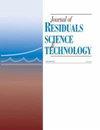人工湿地中多环芳烃污染污泥的植物修复研究
引用次数: 0
摘要
废水污泥从大城市已经成为一种多环芳烃(多环芳烃)的来源,并可能导致污染的土壤和植物如果应用于农业领域。污水污泥在农用地上应用前,对其进行稳定处理是十分重要的。人工湿地在污泥稳定方面得到了广泛的应用。在化粪池中,植物,特别是芦苇,促进根际污染物的降解,是多环芳烃污染污泥植物修复的主要机制。我们在为期3年的现场实验中研究了芦苇(芦苇)种植的污泥中多环芳烃的去除,其中包括2年的污泥施用和1年的休息。给料污泥中多环芳烃的平均含量为5.7 mg kg-1 (DW),其中低分子量(2-3环)多环芳烃约占48%,中等分子量(4环)多环芳烃约占27%,高分子量(5-6环)多环芳烃约占25%。3年后,稳定污泥中PAH的平均含量为2.1 mg kg-1 (DW),低于给料污泥。总的来说,大约66%的低分子量多环芳烃(主要类型)middle-molecular-weight多环芳烃的57%和32%的高分子量多环芳烃从稳定污泥被移除。稳定污泥中多环芳烃含量存在空间差异,表层(12 ~ 14 cm)污泥中多环芳烃含量最高,中层(6 ~ 8 cm)较低,底层(0 ~ 2 cm)最低。本文章由计算机程序翻译,如有差异,请以英文原文为准。
Phytoremediation of PAHs-contaminated Sludge in a Constructed Wetland
Wastewater sludge from metropolitan areas has become a source of polycyclic aromatic hydrocarbons (PAHs), and may result in pollution of soils and plants if applied to agricultural areas. It is important to stabilize wastewater sludge before its application to agricultural land. Constructed wetlands (CWs) have been widely applied for stabilization of sludge. In CWs, plants, especially reeds, promote degradation of pollutants in the rhizosphere and are the principal mechanisms for PAH-contaminated sludge phytoremediation. We studied PAH removal in sludge planted with Phragmites australis (common reeds) in onsite experiments over a 3-year period comprising 2 years of sludge application and 1 year of resting. The average PAH content in the feeder sludge was 5.7 mg kg–1 (DW), consisting of approximately 48% low-molecular-weight (2–3 ring) PAHs, 27% middle-molecular-weight (4 ring) PAHs and 25% high-molecular-weight (5–6 ring) PAHs. After 3 years, the average PAH content in stabilized sludge was 2.1 mg kg–1 (DW), which was lower than that of the feeder sludge. Overall, about 66% of low-molecular-weight PAHs (dominant type), 57% of middle-molecular-weight PAHs and 32% of high-molecular-weight PAHs were removed from the stabilized sludge. Additionally, there were spatial variations in PAHs in stabilized sludge, with PAHs being highest in the surface layer (12–14 cm) sludge, lower in the middle layer (6–8 cm) and lowest in the bottom layer (0–2 cm).
求助全文
通过发布文献求助,成功后即可免费获取论文全文。
去求助
来源期刊

Journal of Residuals Science & Technology
环境科学-工程:环境
自引率
0.00%
发文量
0
审稿时长
>36 weeks
期刊介绍:
The international Journal of Residuals Science & Technology (JRST) is a blind-refereed quarterly devoted to conscientious analysis and commentary regarding significant environmental sciences-oriented research and technical management of residuals in the environment. The journal provides a forum for scientific investigations addressing contamination within environmental media of air, water, soil, and biota and also offers studies exploring source, fate, transport, and ecological effects of environmental contamination.
 求助内容:
求助内容: 应助结果提醒方式:
应助结果提醒方式:


